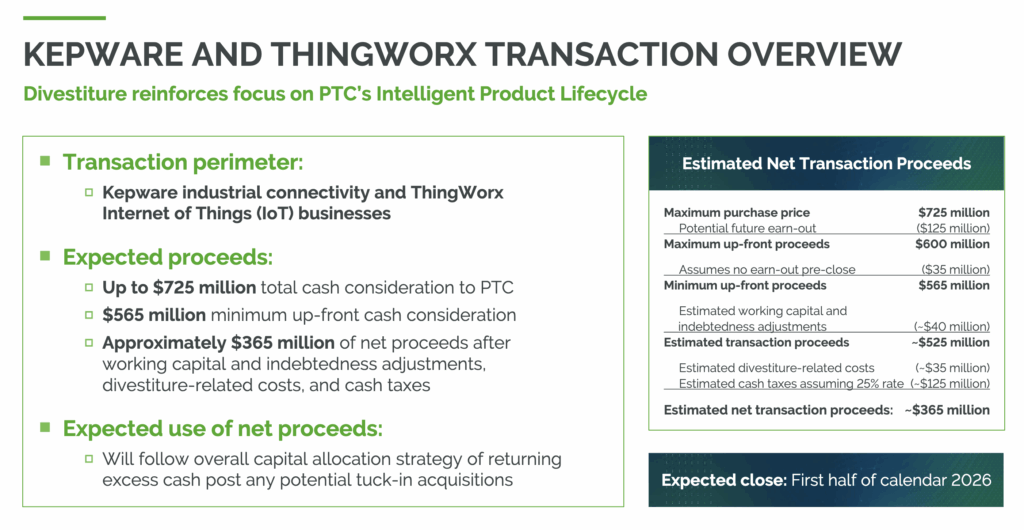Big tech’s big problem with IoT – as PTC sells Kepware, ThingWorx for up to $725m – RCR Wireless

Report on the Acquisition of PTC’s IoT Businesses by TPG and its Implications for Sustainable Development Goals
Executive Summary
Private equity firm TPG has entered into an agreement to acquire the Kepware and ThingWorx business units from industrial software company PTC for a total consideration of up to $725 million. This strategic divestiture marks a significant shift in PTC’s focus towards its core product lifecycle management (PLM) portfolio, while TPG consolidates its position in the industrial connectivity and software sector. This transaction has profound implications for advancing several United Nations Sustainable Development Goals (SDGs), particularly SDG 9 (Industry, Innovation, and Infrastructure) and SDG 12 (Responsible Consumption and Production), by fostering specialized solutions for sustainable industrialization.
Transaction Details and Strategic Rationale
The acquisition reflects a strategic realignment for both PTC and TPG, aimed at optimizing resources to drive innovation in distinct segments of the industrial technology market. This move is poised to enhance the development of infrastructure critical for sustainable manufacturing.
Financial Overview
- Total Consideration: Up to $725 million.
- Upfront Payment: An expected $565 million to $600 million upon closing.
- Potential Earn-out: A future potential of $125 million based on performance criteria.
- Acquired Assets’ Revenue: The Kepware and ThingWorx units generate approximately $200 million in annual revenue.
Strategic Imperatives and Alignment with SDG 9
The deal is driven by clear strategic objectives that align with the principles of fostering resilient infrastructure and promoting sustainable industrialization as outlined in SDG 9.
- PTC’s Enhanced Focus: PTC will concentrate its resources on its core ‘intelligent product lifecycle’ offerings, including CAD, PLM, ALM, and SLM. This sharpened focus aims to improve the entire product lifecycle, from design to end-of-life, directly contributing to more efficient and less wasteful production systems, a key target of SDG 9 and SDG 12.
- TPG’s Industrial Platform Consolidation: TPG is building a formidable industrial software portfolio. This acquisition, following its purchase of GE Vernova’s Proficy business, creates an integrated platform for industrial connectivity and data orchestration. Such a platform is a foundational element of the innovative infrastructure required to achieve sustainable industrial growth.
Impact on Sustainable Industrialization and Resource Management
This market shift towards specialized providers is expected to accelerate the adoption of technologies that support sustainable development by enabling more efficient and responsible industrial operations.
Fostering Innovation for Responsible Production (SDG 9 & SDG 12)
The transaction underscores a market trend where specialized entities may be better equipped than large, diversified technology firms to execute and scale industrial IoT (IIoT) solutions. This specialization can lead to more effective tools for industry.
- Enhanced Connectivity for Efficiency: Kepware’s role in connecting industrial automation devices and ThingWorx’s IoT platform capabilities are crucial for collecting and analyzing data from manufacturing processes. Under TPG’s focused ownership, these platforms can be further developed to help industries optimize resource use, minimize waste, and reduce energy consumption, directly supporting SDG 12.
- Democratizing Technology for SMEs: By creating scalable and potentially more accessible solutions, TPG can empower Small and Medium-sized Enterprises (SMEs) to adopt IoT and smart manufacturing practices. This promotes inclusive and sustainable industrialization, a core tenet of SDG 9, by allowing smaller players to improve their operational efficiency and sustainability performance.
Strengthening Infrastructure for a Sustainable Future (SDG 7 & SDG 11)
The technologies at the center of this deal are instrumental in building the smart infrastructure necessary for sustainable cities and clean energy systems.
- Optimizing Energy Systems: Kepware’s application in the utilities and energy sectors provides a direct link to SDG 7 (Affordable and Clean Energy). Enhanced data collection and control capabilities enable more efficient management of energy grids and production facilities, contributing to a more sustainable energy infrastructure.
- Building Smart Manufacturing Ecosystems: The integration of connectivity (Kepware), data analysis (ThingWorx), and manufacturing execution systems (Proficy) creates a powerful toolkit for smart manufacturing. This is a cornerstone for developing the sustainable industrial parks and resilient infrastructure envisioned in SDG 11 (Sustainable Cities and Communities).
Conclusion
The acquisition of Kepware and ThingWorx by TPG represents more than a corporate transaction; it signals a maturation of the industrial technology market towards focused, specialized solutions. This strategic realignment is critically important for accelerating progress on the Sustainable Development Goals. By enabling PTC to deepen its impact on sustainable product lifecycle management and empowering TPG to build a comprehensive platform for industrial efficiency, this deal promises to unlock new opportunities for innovation, responsible production, and the development of resilient, sustainable industrial infrastructure in line with SDG 9 and SDG 12.
Analysis of Sustainable Development Goals in the Article
1. Which SDGs are addressed or connected to the issues highlighted in the article?
The article primarily discusses a major business acquisition in the industrial technology sector, focusing on Industry 4.0, the Internet of Things (IoT), and manufacturing software. Based on this, the following Sustainable Development Goals (SDGs) are relevant:
- SDG 9: Industry, Innovation, and Infrastructure: The core of the article revolves around technologies like IIoT platforms (ThingWorx) and industrial connectivity software (Kepware) that are fundamental to building resilient infrastructure, promoting inclusive and sustainable industrialization, and fostering innovation. The discussion of “Industry 4.0 strategy,” “smart manufacturing,” and “digital transformation of the shop floor” directly aligns with the objectives of this goal.
- SDG 8: Decent Work and Economic Growth: The article highlights significant economic activity, including a corporate acquisition valued at up to “$725 million” and annual revenues of “$200 million” for the sold units. These transactions and the strategic goal of achieving “operational excellence” and improving “production processes” contribute to economic productivity and growth, which are central themes of SDG 8.
- SDG 17: Partnerships for the Goals: The acquisition of Kepware and ThingWorx by TPG from PTC is a clear example of a private-sector partnership. The article states that TPG will provide “additional capital and expertise” to foster growth. This mobilization of financial resources and expertise between corporate entities to achieve strategic objectives reflects the principles of partnership outlined in SDG 17.
2. What specific targets under those SDGs can be identified based on the article’s content?
Several specific targets under the identified SDGs can be linked to the information presented in the article:
- Under SDG 9 (Industry, Innovation, and Infrastructure):
- Target 9.2: “Promote inclusive and sustainable industrialization…” The article’s focus on “Industry 4.0” and “smart manufacturing” technologies, which aim to modernize industrial processes, directly supports this target. The acquisition is intended to strengthen the development and deployment of these technologies, which are key to advancing industrialization.
- Target 9.4: “Upgrade infrastructure and retrofit industries to make them sustainable, with increased resource-use efficiency…” While not explicitly mentioning sustainability, the technologies discussed, such as IoT platforms that “connects systems, analyzes data,” are enablers for achieving greater efficiency. The goal of “operational excellence,” as mentioned by analyst Craig Resnick, implies optimizing processes, which often leads to reduced waste and more efficient use of resources.
- Target 9.b: “Support domestic technology development, research and innovation…” The deal represents a significant investment in the industrial software sector. TPG’s plan to provide “additional capital and expertise for new Industry 4.0 growth” is a direct effort to support and advance technology development and innovation within this field.
- Under SDG 8 (Decent Work and Economic Growth):
- Target 8.2: “Achieve higher levels of economic productivity through diversification, technological upgrading and innovation…” The entire article is a case study in this target. It describes how companies are using advanced technology (“AI,” “SaaS,” “IoT”) for “digital transformation” to “manage and improve their production processes.” This technological upgrading is explicitly aimed at increasing productivity and achieving “operational excellence.”
- Under SDG 17 (Partnerships for the Goals):
- Target 17.17: “Encourage and promote effective public, public-private and civil society partnerships…” The acquisition is a large-scale private-private partnership. TPG, an asset management firm, is partnering with the acquired software businesses (Kepware and ThingWorx) to build a “formidable industrial software portfolio.” This collaboration leverages financial resources and strategic expertise to drive growth and innovation.
3. Are there any indicators mentioned or implied in the article that can be used to measure progress towards the identified targets?
The article does not mention official UN SDG indicators, but it contains several quantitative and qualitative data points that can serve as proxies or implied indicators for measuring progress:
- For SDG 9 (Targets 9.2, 9.b):
- Indicator: Financial investment in industrial innovation and technology.
Evidence from the article: The deal value of “up to $725 million” that TPG is paying for the two industrial technology units serves as a direct financial measure of investment in this sector. This indicates the mobilization of capital to foster innovation. - Indicator: Revenue generated by industrial technology businesses.
Evidence from the article: The article states that Kepware and ThingWorx “deliver about $200 million in annual revenue,” which can be used as an indicator of the economic scale and market value of Industry 4.0 technologies.
- Indicator: Financial investment in industrial innovation and technology.
- For SDG 8 (Target 8.2):
- Indicator: Adoption of advanced technologies for productivity improvement.
Evidence from the article: The article describes the function of the software as enabling the “digital transformation of the shop floor” and helping customers “manage and improve their production processes.” The acquisition and consolidation of these platforms by TPG imply a growing market and increased adoption of these productivity-enhancing technologies by manufacturers and other industrial clients.
- Indicator: Adoption of advanced technologies for productivity improvement.
- For SDG 17 (Target 17.17):
- Indicator: Value of private-sector partnerships for technology development.
Evidence from the article: The total cash consideration of “up to $725 million” for the acquisition is a direct monetary indicator of the scale of this private-private partnership aimed at advancing industrial technology.
- Indicator: Value of private-sector partnerships for technology development.
4. Summary Table of SDGs, Targets, and Indicators
| SDGs | Targets | Indicators (as mentioned or implied in the article) |
|---|---|---|
| SDG 9: Industry, Innovation, and Infrastructure |
|
|
| SDG 8: Decent Work and Economic Growth |
|
|
| SDG 17: Partnerships for the Goals |
|
|
Source: rcrwireless.com
What is Your Reaction?
 Like
0
Like
0
 Dislike
0
Dislike
0
 Love
0
Love
0
 Funny
0
Funny
0
 Angry
0
Angry
0
 Sad
0
Sad
0
 Wow
0
Wow
0
















































/environment-climate-change-and-health-(ech)/water-sanitation-hygiene-and-health-(wsh)/landfill-tuvalu-36092.tmb-1200v.jpg?sfvrsn=5c21fe40_1#)

.jpg.webp?itok=0ZsAnae9#)

























